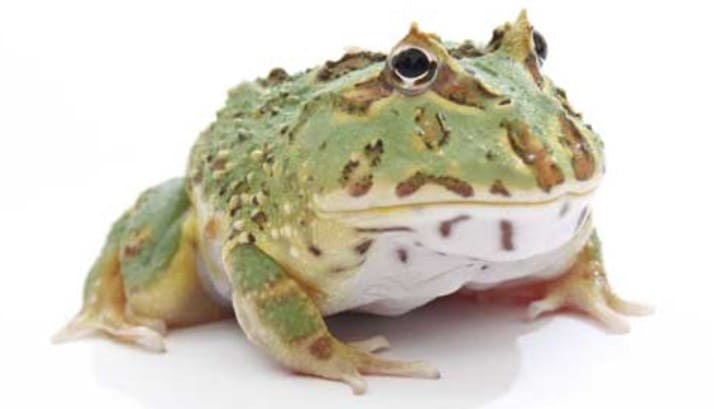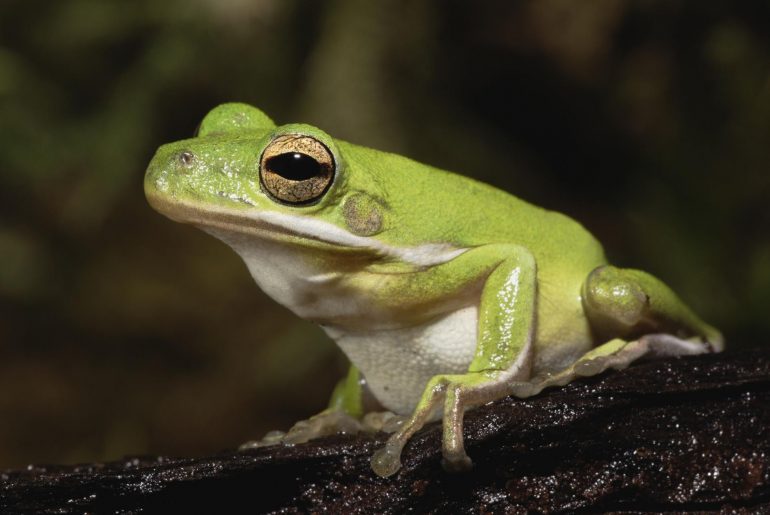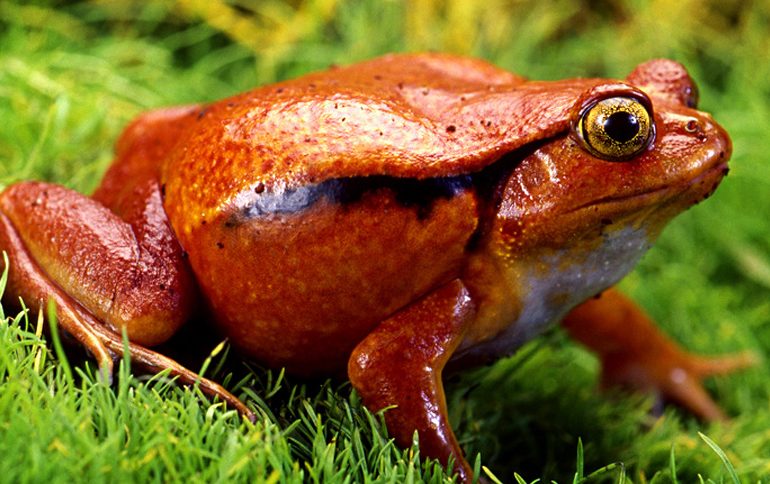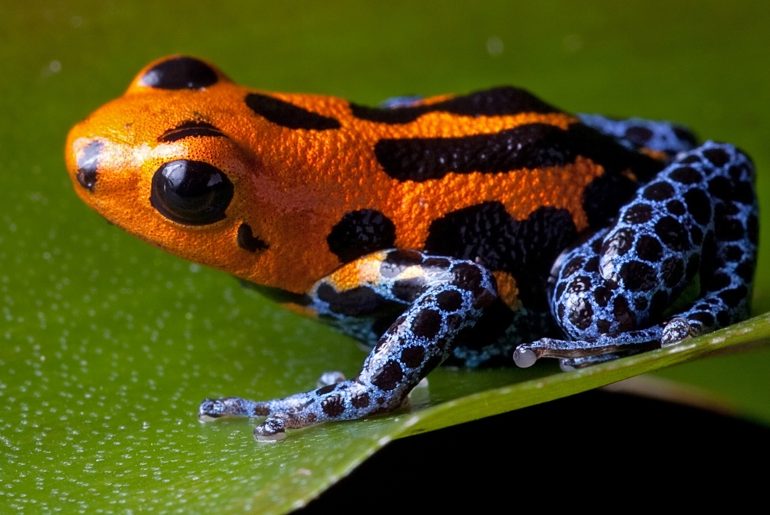Terrarium equipment/ technology
Although or precisely because horned frogs are twilight and nocturnal, it is essential for the frogs to create a day/night rhythm. It is by no means to be assumed that the normal daylight in the room is sufficient. Rather, it is important to additionally illuminate the terrarium using neon tubes and/or spotlights. Irradiation with UV lighting is not necessary, but leads to stronger colors to a small extent and contributes to health in any case. The lighting time always depends on the season, whereby it is also possible to keep it all year round with 12-14 hours of light per day. However, the most natural thing is to adjust the daylight length in the terrarium to the daylight “outside”, regardless of whether you want to send your animals to dry rest or not (most specimens “treat” their dry rest break independently from the second year of life anyway) .
This roughly means: 8-10 hours of light in winter and 12-14 hours in summer.
Spotlights also serve as a heat source in the terrarium. Horned frogs prefer temperatures of 24-28°C, but will certainly tolerate higher values for a certain time, but deaths have already been reported due to being kept too warm over a longer period of time, so it can be said that the temperature should never be 30°C or more for a long time . Unlike in many other cases of terraristics, care must be taken here that the temperature in the terrarium does not vary too much, since horned frogs are unfortunately not always among the “brightest candles on the cake” and sometimes live in an actually unfavorable temperature, i.e. too cold place bury in the terrarium. At night, however, the temperature can drop to around 19-21°C and be kept at these values, e.g. with thermostat-controlled ceramic heaters or heating cables attached to the side of the terrarium (!!). ATTENTION: Since frogs bury themselves to cool down, please never lay a heating cable under the terrarium. The animals would not understand why, despite digging deeper, it is getting warmer and warmer and could therefore easily overheat
All lamps used should be controlled by timers to ensure an even day/night rhythm adapted to the season. The spotlights should always (!!!) be at a sufficient distance from the animal to prevent the frog from overheating or even “grilling”. The well-known ThermoTimers, for example, have proven their worth here.
In order for the horned frog to really feel comfortable, the relative humidity should be around 70-80% during the day and can or should rise to 80-90% at night. This is achieved by regularly spraying part of the terrarium, whereby the animals themselves should not be sprayed and a drier area must always be available to them. A simple atomizer or plant sprayer is therefore part of the absolute basic equipment of a horned frog terrarium. In order to always ensure precise control of the relative humidity and temperature in the terrarium, the use of thermo-hygrometers is recommended. Everything can be read off here precisely and measures can be taken if necessary if a value deviates from the optimal value.
When choosing the right substrate, there are a wide variety of options and each individual substrate certainly has its advantages and disadvantages. For a long time we used “active” forest soil from a nearby mixed forest, although as the number of frogs increased, we eventually switched to the well-known coconut humus bricks from the terrarium store… it was just annoying to have fresh soil every 4-6 weeks in the amounts we needed ” to lug it along”, it was significantly easier – albeit more expensive – to stock up on the small pressed bricks in order to always have fresh ground available. However, the forest soil had the advantage that it already contains various microbiologically important bacterial cultures which help to break down faeces and urine residues that we have overlooked and thus in turn contribute to a better, cleaner terrarium climate. A compromise between the two variants would certainly be ideal, i.e. by mixing the coconut soil with freshly collected forest soil and thus “inoculating” something, i.e. creating an “initial culture” of cleaning or excrement-degrading microorganisms.
However, the task of the substrate is not only to absorb and bind excrement, but rather is a complex habitat for the animals or a place of retreat that provides security. They just love to bury themselves in there completely after a big meal and digest it in peace, only to reappear a few days later and just look out of the ground to wait for the next passing prey.
Newspaper and kitchen paper or filter sponges, such as those used very often in the United States or Japan, not only look unappealing, but also deprive the animals of one of their innate natural behaviors, since burrowing is not possible here. We therefore only use it during quarantine and will not explain it further here. However, we will also deal with these materials in the “Quarantine” section.
We also put a layer of dried fallen leaves in the terrarium because of the beautiful look, but above all as an additional retreat for the frogs. However, the leaves should never be collected from roadsides, as these leaves are often heavily polluted by car exhaust fumes. The risk that the trees have been treated with pesticides should also be ruled out in order not to harm the animals.
The setup of the terrarium is completed by a small, flat bowl with fresh water. It is important to ensure that the water level is not too high in order to avoid drowning of the unfortunately clumsy and poorly swimming silver-horned frog. The water should be changed every 2-3 days at the latest, depending on how dirty it is. Especially after eating, some specimens like to go in there to drop their droppings into the water, which of course makes cleaning the terrarium easier. The bowl should also stand securely and not be too heavy so that it does not pose a danger to the animal if it is undermined. Tip: In the garden and DIY store you will find appealing planters or saucers, etc., which are very suitable for our purposes.
Planting
It is certainly commendable to want to beautify your terrarium with real plants, as these contribute to a great extent to the natural appearance of the terrarium, a more constant relative humidity and a greater sense of security for the terrarium occupants. It is also quite possible to care for such a terrarium with horned frogs and if you have a “green thumb” it is not uncommon for real optical gems to be created which will stand out in every living room, but this is also associated with a greatly increased care effort. The care of the living plants is often more complex than that of the animals themselves. For this reason, we use artificial plants in all terrariums in a wide variety of designs. This gives the terrarium a “natural” appearance and provides privacy for the animals. We regulate the humidity anyway by spraying over individual parts of the pool.
Feed procurement
There are now many pet shops that offer various insects, beetles, worms, rodents, fish and even ready-made food for the various terrarium animals. However, these feed animals should be “fed” for another 2-3 days, since the insects in pet shops in particular often only get insufficient or inferior food or no food at all, which of course enormously reduces their nutritional value. In addition, it should be ensured that the feed animals purchased come from a healthy, parasite-free breed in order to avoid diseases from contaminated feed. If you have the space and the desire to care for several animals, you can of course set up your own insect farm, cockroaches in particular are ideal for this. This has the advantage that you have precise control over the feed of the later prey animals and thus also over their quality as food for our frogs and that you always have inexpensive food on hand. We always have a supply of smelt and baby mice in the freezer, you can also easily buy these in pet shops and build up a supply at home. There are now even some suppliers/breeders on the Internet from whom you can get high-quality insects and frozen food (smelt, mice, etc.) at a moderate price and have them delivered to your front door by parcel post. Frozen food has the clear advantage that you always have a supply ready. In addition, the food animals are already dead, which also protects our terrarium protégés from injuries (e.g. bites or nibbling) by uneaten food animals. The often-heard thesis that vitamins are destroyed when freezing is nonsense – we humans would probably have died of vitamin deficiency long ago if that were the case… just think of the good spinach with the “Blubb”… Nevertheless should not be stored for too long, after 4-6 months it should be used up at the latest, since too long storage can have a lasting effect on the quality as a feed animal.
Feeding
We feed our frogs with various insects such as house crickets, crickets, cockroaches, etc. as well as fish (smelt), worms and very rarely (!) a baby mouse. We feed adult animals that we use for breeding about every 7 days, since the females can draw on the reserves they have eaten up before, or rather when they are laying their eggs, so the meal can be a little more sumptuous than with the males. However, it is always important to ensure that you do not let your animals become fat. In addition, the feed animals should always be dusted with D3 vitamin and calcium to prevent a possible undersupply of vitamins and calcium. Calcium in particular is very important to ensure firm and even bone growth. We recommend, for example, sepia peel from the pet shop which, when ground into a fine powder, can be dusted on the feed animals and cannot be overdosed. Excess calcium from cuttlebone is simply excreted with the next store. The product “Herpetal Amphib” has also proven itself, which was specially tailored to the needs of amphibians and thus also to our horned frogs and, like other vitamin preparations, is administered by dusting the feed animals. In order to prevent nuisance or even danger from uneaten prey animals as well as contamination of the terrarium by dead prey animals, we recommend feeding the individual frogs with tongs/tweezers. Most frogs get used to this type of feeding very quickly and it is very precise Control over the eaten feed animals and quantities.
Quarantine
For safety reasons, sick animals and new arrivals are housed in quarantine tanks to protect the old population. They remain there until the disease has healed, or in the case of new animals that are to be integrated into an existing stock, a disease is ruled out. This ensures that sick frogs cannot infect the healthy stock animals. Quarantine terrariums are set up with the simplest of means to ensure perfect hygiene at all times. Some kitchen paper or, as in America and Japan, the finest aquarium filter sponges as substrate, an easily accessible and disinfectable cave (e.g. plastic flower pot) and a water bowl – nothing more. Of course, as in a normal terrarium, the climatic data must also be observed here. During the quarantine period, faecal samples are given to the vet for examination, who will then examine the faeces for parasites and treat them if necessary. Alternatively, you can of course also send the stool samples for examination yourself.
Socialization
Since horned frogs are cannibalistic and also loners who only come together in nature during the mating season to ensure reproduction. Strict single keeping applies to all Ceratophrys species! Every movement in the terrarium is equated with food and an attempted socialization is almost certainly the death sentence for at least one of the animals! So the rule is: one terrarium per frog – without exception.
Maintenance effort
The maintenance effort for a horned frog terrarium can be classified as very low compared to the maintenance of a cat or a dog. The settled pile of excrement should always be removed as soon as possible. This is best done with a small scoop, spoon, or discarded “ice ball maker”. Of course, this equipment must always be cleaned thoroughly after use and, if necessary, disinfected with suitable disinfectants. In addition, you have to keep an eye on the climate values and regulate something if necessary (spraying, higher or lower wattage of the lamps, etc.). The water is changed at least every 2-3 days (immediately if it is dirty). Tap water is usually perfectly fine. Theoretically, you could ask your waterworks whether it is safe to use for the preparation of baby food (asking about frogs is always a bit stupid). If they think it’s not recommended for preparing baby food, then it probably shouldn’t be used for frogs either. Unfortunately, I don’t know whether such bad tap water still exists in Germany today – in any case, it can be used without hesitation here. Tap water is the most strictly controlled and monitored foodstuff of all… If it is heavily chlorinated, you can let it stand for 24 hours and let it outgas. If copper pipes are laid in the house (keyword instantaneous water heater), let the water run for a while (e.g. take a shower yourself) and only then fill up the water for the frog. You don’t need to decalcify or boil the animals’ bath water.
For the spray water, on the other hand, clean rainwater makes sense, for example, if you want to avoid limescale stains on plants and windows. Otherwise, you should replace the entire substrate every 2-3 months, clean the windows of the terrarium from time to time and always replace defective lamps/heating agents – a lot no more effort is required. Compared to the pets mentioned above, this means significantly less work (cleaning the litter box several times a day, feeding them daily, walking them, etc.)!
Are Pacman frogs easy to care for?
Pacman frogs are not difficult to care for and they make interesting pets. However, for people who like their pets to be active or interactive, the Pacman frog may not be a good match, as it is not the best pet for handling.
Do Pacman frogs like to be held?
Pacman frogs have sensitive skin and do not enjoy being handled. Try not to handle new Pacman frogs for 3 or 4 days to give them a chance to get acclimated to their new surroundings.
What does a Pacman frog need?
A diet consisting of a variety of insects is recommended. They are ambush predators which feed on crickets, roaches, waxworms, mealworms, and the occasional pinky mice. In captivity, it’s hard for a Pacman frog to obtain all the nutrients they need from just crickets, roaches, and worms you find at the pet store.
How often should I hold my Pacman frog?
Pacman frogs should not be handled unless absolutely necessary. Handling is bad for the frogs sensitive skin, they may try chomp one of your fingers!
What happens if I drop my Pacman frog?
Most frogs have a very small rib cage and loose bones just for this purpose. Check her tummy and legs for any tender or weird spots and look for discoloration that might be associated with bruising. She should be fine, just watch out for any behavioral changes, physical changes, etc.
Do Pacman frogs need a heat lamp?
Pacman Frogs require a daytime temperature between 75 and 85 degrees Fahrenheit. This temperature is warmer than most households, which means that extra heat sources are necessary for Pacman Frogs.
Do PacMan frogs need a water bowl?
As long as you keep the substrate moist, a water bowl isn’t a necessity. Pac-Man frogs will also use hiding spots, so they should be provided. Live plants, such as Pothos, not only provide hiding spots but also help to process feces and CO2.
What happens if a PacMan frog gets too cold?
Additionally, it will stop eating when it is too cold. Not only because frogs become lethargic, but also because their bodies are simply not able to digest food under that temperatures. If low temperatures persist, they will stay in estivation until it gets warmer or until they die.
How do I keep my PacMan frog warm at night?
A low wattage heat lamp may be used to provide ample heat in the PacMan frog terrarium. Heat lamps are either incandescent bulbs or LED bulbs specifically manufactured to supply heat for reptiles and amphibians. The higher the wattage of the bulb, the more heat it will produce.






